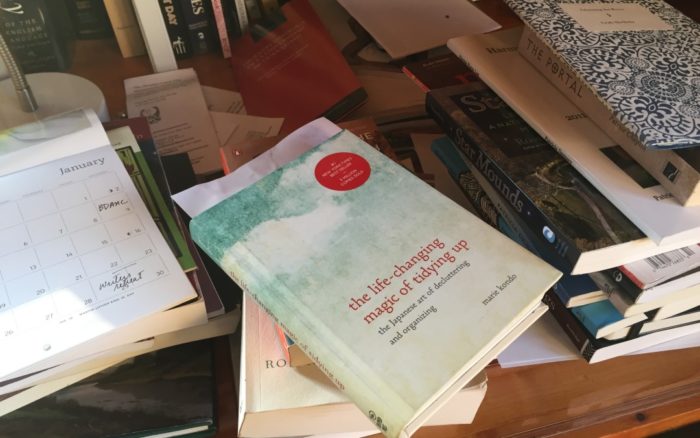Meditation on Space: The Life-Changing Magic of Tidying Up
The Life-Changing Magic of Tidying Up: the Japanese Art of Decluttering and Organizing, by Marie Kondo (Ten Speed Press, 2014), is truly magical in its meditation on the space of your home. The tiny book can easily be held in your hand like a manual of life as you head into piles and clutter. The headings draw you in (It has for many—it is a New York Times Bestseller): Why can’t I keep my house in order?; Finish discarding first; Storing your things to make your life shine; The magic of tidying dramatically transforms your life.
I have been aware for a while of the too muchness of our culture, how goods are forced on us by advertising and made easily-bought by being cheap and often not lasting very long. When my parents died, my siblings and I were left to clean out their packed home of not only their own belongings, but my grandparents’ and great grandparents’ stuff as well, all who had lived in the house before my parents. As my husband so aptly put it, no one ever moved out! Throwing their stuff out was a burden of decades of not letting go of what was no longer needed or useful! (See On Materialism)
Kondo’s technique is unique from other decluttering books and articles, in that it sorts not by what you use but whether that item brings joy. “We should be choosing what we want to keep, not what we want to get rid of,” Kondo asserts. She recommends holding each item in your hand and asking this question, “Does this spark joy? If it does, keep it. If not, dispose of it (p. 41).”
This question, simple as it is, initiates transformation. It is a question that our culture overrides all too often. Some years ago after a particularly stressful time, my physician ordered me to do nothing that I didn’t want to do for two years! I recovered without a serious illness. I have carried this into the present as a guiding star, and now Kondo has extended this principle into sorting the items in my home.
It is a shocking process: it is all there: the gold pants I paid too much for and keep out of guilt, even though I don’t wear them because they doesn’t suit me any more. The gifts that don’t “spark joy” but I keep— out of guilt, I guess. But there is more too: the items of times past, items I loved but that are more magnets of memory, not sparklers of joy in the present! All of these situations Kondo addresses. It is a kind of life review of the unconscious meaning of the contents of your home and how they clutter your psyche.
Don’t let Kondo’s obsessiveness allow you to discredit the value of her method. She lost me in a few places— and I get obsessive myself. While her method of folding clothes may have value, it crosses the line for me. And I will always have more than 30 books (which she keeps in a closed closet on one shelf). But the bedrock of her method: relating to our possessions, valuing them, being conscious of what we have and why: this is transformational. It is not that we should be less materialist, as Episcopal priest Robert Farrar Capon stated in his decades old book, Bed and Board. We need to be more so. Capon wrote, “Perhaps the largest single trouble with our abundance of possessions is the fact that so many of them are owned, not because of what they are, but of what they confer on us. They are there, but we seldom look at them. We have so much, but we love precious little of it for itself.”¹
Kondo’s method will help you rediscover the beingness of those items you live with and will give permission to let go of those items which deaden your perception. Clutter of our home environments does reflect clutter of the mind. And by extension, when we relate to the material world as if it is there only for what it confers on us, we exploit our dear Earth for her resources, regardless of the impact on everything and everyone else.
Kondo brings this idea home.
¹Bed and Board: Plain Talk About Marriage, by Robert Farrar Capon. Simon and Schuster, 1965, p.115.
